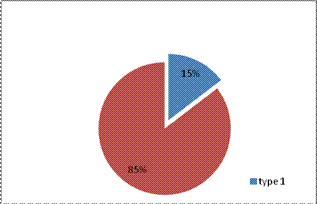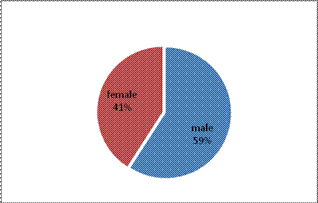Official Journals By StatPerson Publication
|
Table of Content - Volume 5 Issue 1 - January 2018
. Assessment of thyroid dysfunction among diabetic patients attending to a rural teaching hospital Vasundhara Devi Dundi1, Nagababu Pyadala2,3*, Rathna Giri Polavarapu4
1Associate Professor, 2Assistant Professor, Department of Biochemistry, MNR Medical College and Hospital, Sangareddy, Telangana State, INDIA. 3Research Associate, Department of Clinical Research Laboratory, Genomix Molecular Diagnostics Pvt. Ltd, Kukatpally, Hyderabad, INDIA. 4President and CEO, Genomix CARL Pvt. Ltd, Pulivendula, Andhra Pradesh, INDIA. Email: nagababu00799@gmail.com
Abstract Aim: The present study aimed to find out the prevalence of thyroid dysfunction among diabetic patients in a rural teaching hospital. Materials and Methods: Two hundred twenty (220 cases) known diabetic patients who attended the Department of Medicine, included in this study. The study was done in the Department of Biochemistry, MNR Medical College and Hospital, Sangareddy, Telangana State, India. Results: Both hypothyroidism (60 cases) and hyperthyroidism (07 cases) significantly seen in known DM patients. Conclusion: Hypothyroidism was the most common kind of thyroid disorder encountered in our study Hypothyroidism is the most prevalent thyroid dysfunction found in DM patients. The progression of hypothyroidism may increase the risk of Cardiovascular disease in DM patients through inter-relationships with vascular endothelial dysfunction, dyslipidemia and insulin resistance. Key Words: Diabetes mellitus, Hypothyroidism, Prevalence, TSH, T3, T4, Thyroid dysfunction.
INTRODUCTION In India, the prevalence of thyroid dysfunction is increasing day by day. Around forty million people are suffering from thyroid dysfunction in India. Especially the incidence of thyroid dysfunction is more in the diabetic population. So this may be the reason to have a high prevalence of thyroid dysfunction in India. India is a nation where diabetes mellitus is increasing rapidly1,2. Due to this World Health Organization (WHO), declared India as the diabetes capital of the world. According to International Diabetes Federation (IDF) by 2020, 70 million people are going to live with diabetes. By this, we understood that if a patient is affected by one autoimmune disease tends to develop another autoimmune problem. So far among thyroid dysfunction, hypothyroidism is the most common and accounts 4-15 % of the total population. Thus the present study aimed to assess the thyroid dysfunction among diabetic population attending to a rural teaching hospital3,4. By this study practicing doctors can get the information regarding the relations of thyroid dysfunction among the diabetic population and helps in the management of further complication.
MATERIALS AND METHODS The present study was carried out at MNR medical college and Hospital (600 beds teaching hospital catering to Sangareddy population) situated in Sangareddy, Telangana state. A total of 220 study subjects of both gender groups were selected from the medicine ward MNR medical collegeand hospital during the period from May 2017 to August 2017. This study approved by institutional ethical committee and investigations were carried out in the biochemistry laboratory, MNR medical college and Hospital, sangareddy. The study sample included 220 patients who were known diabetic and who attended regular clinical checkup in the Department of Medicine, MNR medical college and Hospital, sangareddy. The detailed clinical examination conducted and the fasting blood samples were collected and sent to the Central Laboratory for the detailed thyroid function tests. Blood glucose was also estimated. The reports compiled and the statistics were calculated using the latest SPSS-16. Collection of blood sample: Under aseptic conditions, 5ml of venous blood collected into an EDTA and plain vacutainer after confirming as diabetic. Whole blood was allowed to clot and then centrifuged for serum separation. Following estimations are carried out on the serum samples by standard kit methods were as follows.
T3, T4, and TSH-estimated by using (CLIA -method) chemiluminescence immune assay method [4,5,6]. Reference range: The normal reference ranges according to the kits are:
Inclusion Criteria
Exclusion Criteria The patients with a history of thyroid disease, pregnant, radiotherapy to chest and neck areas, drugs, malignancy, patients with chronic illness, were excluded from the study. Statistical Analysis: The collected data were analyzed by SPSS software version 16.0.
RESULTS In the present study, 220 patients included data records of 39 type 1 DM patients and 181 type 2 DM patients as shown in figure 1. Among 39 type 1 DM patients, males are 14 (36%), and females are 25 (64%), and among 181 type 2 DM, men are 107 (60%), and women are 74 (40%) as shown in figure 2 and 3.
Figure 1: Distribution of diabetes among patients
Figure 2: Gender wise distribution of patients among type 1 DM
Figure 3: Gender wise distribution of patients among type 2 DM Table 1: Distribution of Thyroid Function among Diabetic Patients
The prevalence of thyroid dysfunction in all diabetic patients was 30.45%. In the T1DM group, 26 cases were euthyroid, and 13 had thyroid dysfunction. The highest prevalence of thyroid dysfunction cases of hypothyroidism 11 cases, which was followed by Hyperthyroidism 2 cases as shown in table 1. In the T2DM group, 127 cases were euthyroid, and 54 had thyroid dysfunction. The highest prevalence of thyroid dysfunction was of hypothyroidism 49 cases followed by hyperthyroidism 5 cases as shown in table 1.
DISCUSSION Globally the incidence of DM is increasing day by day, especially in developing countries like India. The prevalence of thyroid dysfunction is high in DM patients. DM is organ-autoimmune disorder and likely to produce other autoimmune diseases7. TSH, T3, and T4 are the three hormones estimated and measured to diagnose thyroid dysfunction. In the present study out of 220 DM patients, 153 (69.55%) patients found euthyroid and 67 (30.45%) seen with thyroid dysfunction. So one-third of the DM patients are suffering from thyroid dysfunction. Similar studies reported by Udiong CEJ et al., (2007)8, Nobre EL et al., (2008)9, Radaiedeh AR et al.,(2004)10, Papazafiropoulou A et al.,(2010)11, Perros P et al., (1995)12. In the present study both hypothyroidism and hyperthyroidism significantly seen in the DM patients. Thyroid dysfunction significantly reported in aged persons, with the progression of age the subclinical and clinical hypothyroidism encountered in more in frequency. The present study, the prevalence of thyroid dysfunction is more in females when compared with males. Similar results were reported by Jain G et al., 201313. Both of Thyroid hormones and insulin antagonize each other, and they affect metabolism in body cells, any change of one of them directly or indirectly affects the other14. DM disturbs thyroid function by affecting both the hypothalamic control of TSH production and the transformation of T4 to T3 in the peripheral tissue15.
CONCLUSION Hypothyroidism is the most prevalent thyroid dysfunction found in DM patients. The progression of hypothyroidism may increase the risk of Cardiovascular disease in DM patients through inter-relationships with vascular endothelial dysfunction, dyslipidemia and insulin resistance. Based on our study, we recommend for a regular checkup for the thyroid profile among DM patients to prevent the further complication.
REFERENCE
|
||||||||||||||||||
 Home
Home



